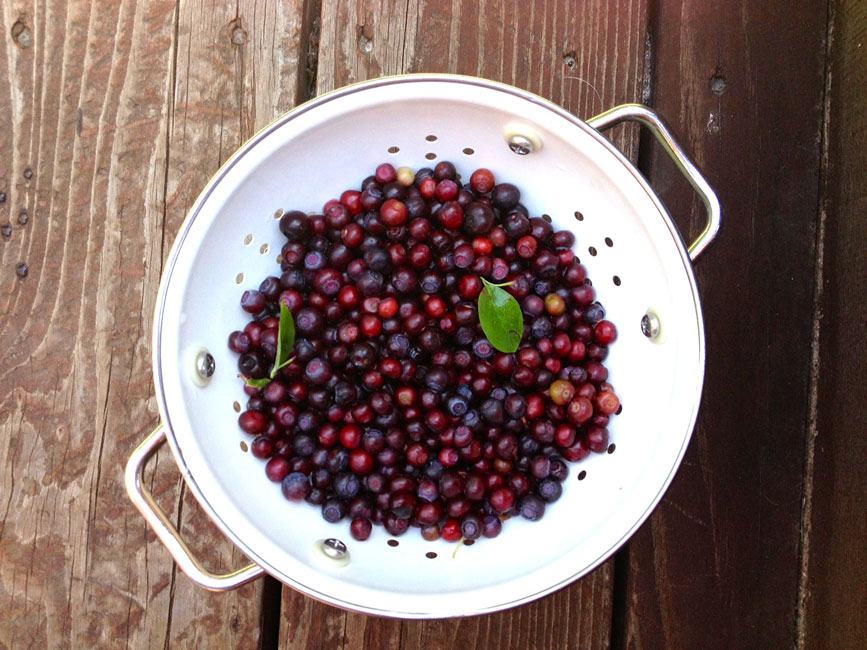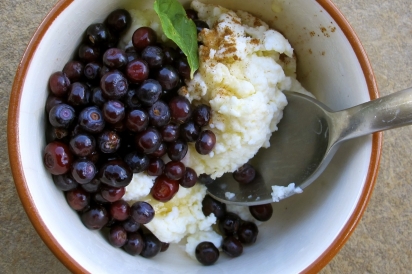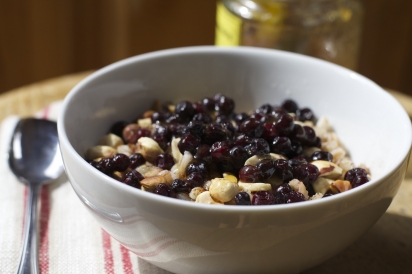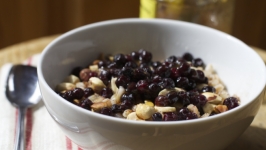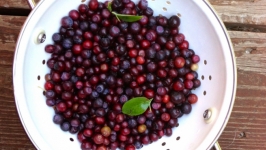Wild About Huckleberries
In the thick of the short picking season, I am plagued by huckleberry envy. Grinning hikers emerge from the woods, their lips stained purplish-blue and their buckets overflowing. Friends smugly stash gallons in the freezer to keep them supplied until the next huckleberry season. Everyone seems to be finding more huckleberries than I.
The Mountain Huckleberry, a wild cousin of the blueberry, is prized for its tartness, which comes from the ten tiny seeds encased in its flesh. The huckleberry has a thicker skin than the blueberry, which allows it to pleasantly pop in the mouth when ripe. The sweet and tart little berries are also prized for their elusiveness. Huckleberries can only be found in the wild; attempts to cultivate them have failed. When I moved to the Tetons, it quickly became clear that if I wanted to be rolling in huckleberry pancakes all winter long, I would need to pick my own.
Yet, when huckleberry season is over, usually shortly after I’ve gotten wind that the berries were “in,” I am filled with regret. If only I’d had more time to pick! Whatever berries I bring home get quickly gobbled up by hungry kids, leaving me with just a few cups to squirrel away in the freezer, never enough to make a huckleberry pie, a small batch of jam or even a huckleberry buckle.
Wondering what the successful huckleberry pickers know that I don’t, I was determined to approach the next season with a premeditated plan of attack. I looked for foragers on both sides of the Tetons who were willing to share their secrets. I wanted the details of the hunt: when to start looking, which elevations to cover, and quick-picking tips. But I knew better than to ask them to give up their secret spots.
I tracked down Libby Hall, a huckleberry enthusiast who plans her summer vacations around the short and sweet season in Jackson Hole. Libby advises the best way to approach huckleberry season is to be observant: notice what’s happening with the flowers, the sunshine and the rains. Take a look at what the birds are feeding on—when the robins and waxwings start munching on a patch of serviceberries that grow wild in her backyard, Libby heads out to look for the huckleberries.
“The problem with huckleberry picking is that they are not that obvious to find: the berries are hidden under the leaves.” Libby says. She advises picking in the rain (“no one else is out there”) and taking your dogs. Libby’s dogs hunt down huckleberries like pigs on truffles; when she hears them rooting around in the brambles, she knows to follow them to a patch.
My paddling friend Caryn Flanagan has a gifted nose for huckleberries. One day last July, we were paddleboarding String Lake in Grand Teton National Park when she tilted her head towards the shore. “Smell that?” she said. “Huckleberries are in.” Sure enough, the air was pungent with the earliest, barely ripe huckleberries clustered in the brambles of the high altitude lake, an area well known to be a favorite among bears.
Caryn has been obsessed with finding huckleberries her entire life. She advises rigging an old mixing bowl with string so that it hangs around the neck. She can pick faster and scale steep slopes better with both hands free. She also brings smaller containers equipped with lids to transfer the precious berries into as she picks; there’s nothing sadder than having a bowl tip over scattering huckleberries into the ground cover.
Finally, my search for huckleberry wisdom brought me to Susan Lykes, whose backyard abuts the foothills of the Big Hole Mountains, a true foraging paradise. Susan’s favorite sound is the drop, drop, drop of the first few huckleberries hitting the bottom of an empty bucket. Last year she and her husband Mayo managed to put up seven gallon-sized bags of huckleberries. “Mayo puts them in oatmeal and I like to bake pies with them. I think my all-time record was collecting 18 pies worth of huckleberries. That was a fun winter!” Susan always brings along a dog as a bear warning system. It’s easy to get so intent on picking berries that you wouldn’t notice a bear right next you in a patch. “Always take your raincoat so you won’t get soaked, and take more containers than you think you’ll need,” she says. “And never be in a hurry.”
Fair enough—no more huckleberry envy and huckleberry regret for me. I am looking forward to the next season with a fresh attitude. How many gallons I bring home won’t matter as much as my time spent in the woods, observant and immersed in the task of berry picking, savoring the sound of the drop, drop, drop of the berries in the bucket.
Victor Emporium
I headed over Teton Pass to pick the brains of the owners of the Victor Emporium, a fishing shop, soda fountain and souvenir store that has been serving “World Famous Huckleberry Milkshakes” for over fifty years. Not only is the Emporium famous for its huckleberry milkshakes, it sits in the center of Victor, Idaho, the huckleberry capital of the state and possibly the world. This small community of 1,200 year-round residents is surrounded on the east, south and west by foothills, forests and high mountains — and miles and miles of mature huckleberry bushes.
The Victor Emporium was famous for its huckleberry milkshakes long before owners Kim Keeley and Kathy Ferris took over fifteen years ago. The Emporium is the place to stop in and have a coffee, read the paper, visit with neighbors, pick up a few flies for the day’s fishing and—more likely than not—order a huckleberry milkshake. The Emporium sold over 42,000 ice creams last year, mostly milkshakes, mostly huckleberry. Kim and Kathy employ an army of foragers — aged five to eighty-five — to keep them in huckleberries year-round. They have 350 gallons of the wild berries, all hand-picked locally from the surrounding mountains, stashed away in the Emporium freezer. That’s 1,750 pounds of huckleberries! And they need every last one to keep up with the demand of their shakes. It takes pickers thirty minutes to gather enough berries for one huckleberry-packed Emporium shake.
After learning the impressive statistics of the huckleberry milkshake capital of the world, I wanted to know the details: when, where, and how do their foragers pick so many huckleberries? Kim and Kathy just shook their heads; their foragers are so secretive that even they don’t know exactly where the huckleberries come from. And with such an impressive cache of berries in the freezer, they no longer head into the hills to pick their own.
String Lake
Grand Teton National Park | @grandtetonnps
Big Hole Mountains
Victor Emporium | @victoremporium


